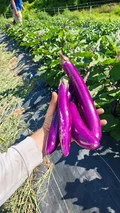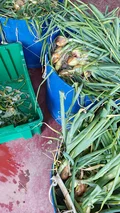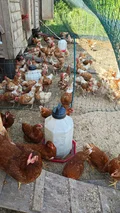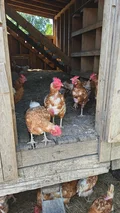TL;DR
We harvested carrots, celery, eggplant and onions, then weeded and moved irrigation a bit. It was a hot, dry, sunny day but ending up with a few pounds of loose carrots made the evening a happy one.
Sharing carrots with friends and community isn’t unlike sharing knowledge via open source work…my roots are in both. Whether there is bounty or scarcity, it’s important to share what we have and learn from each other.
Fresh Carrots Are a Wonderful Thing
Carrots are like candy from the ground. When they are fresh, they are crunchy, earthy, sweet and nutritious. I would rather give them as gifts to others than eat all of them myself, and I do plenty of both
Per medium carrot, you get about 25 calories, 6 grams of carbohydrates, 3 grams of natural sugars and 1.5 grams of fiber (helps with blood sugar control). There’s no protein or fat, but there is Vitamin A (mostly beta-carotene, protects cells from damage), Vitamin K (important for blood clotting and bone health), Vitamin C (an antioxidant that supports the immune system), Potassium (good for healthy blood pressure), and Falcarinol.
There is also a large body of research to indicate that carrots help reduce the risk of a variety of cancers, which is not surprising given the multitude of ways that the micro-nutrient found in carrots apply to cell (re)generation and repair.
So next time you’re at a farmer’s market and have the option to either buy a small bunch of carrots or a pint of ice cream for $5.00, choose the carrots. They help prevent against colorectal cancer, so there’s that.
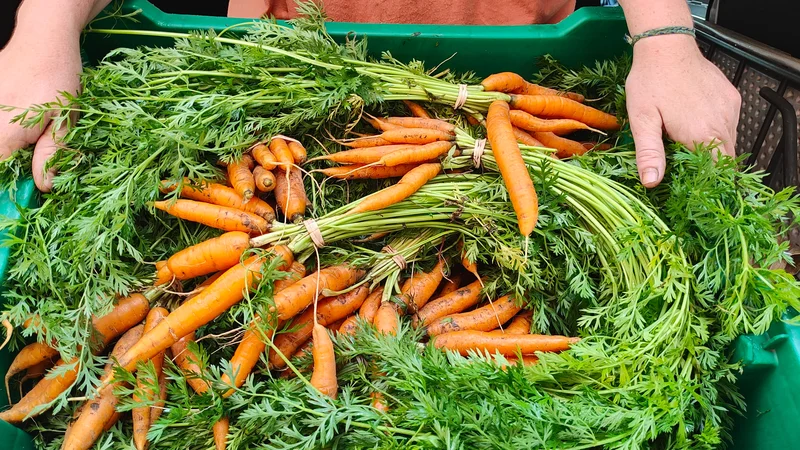
The Economics of Carrots
As the title of this post says, organically grown carrots are a lossy crop. Above-ground pests like bunnies and field mice love to take bites from the root tops poking out of the soil where the greens are exposed. Beetles, wireworms, rust fly larvae, and weevil larvae eat through them underground. Carrot flies in particular lay their eggs in the soil, and the larvae eat the roots but not the greens.
Soil that is too dry can cause carrots to split, and soil that is too wet can cause them to rot. Even when they do grow well, they can be difficult to harvest because they’re so fragile. I recently was forking up some this morning and rocks in the way caused the dry clay soil to come up too shallow, snapping clusters of perfectly fine carrots in half. More than half the carrots in this bed didn’t make it up to the barn for refrigeration.
On the other hand, if space isn’t a dire concern, their seed is very cheap. Even the organic varieties are like 25,000 seeds for $50-$75 at Johnny’s Selected Seeds. It’s not the seeds or the space (opportunity cost) or the time it takes to sow them mechanically. It’s really the labor. With a crew of 4-6 all bunching carrots in the field by hand, it takes about 2 hours (10 person-hours) to get about a hundred viable bunches ready for only half of the week (so we do it twice per week to ensure CSA and market orders). At around minimum wage, this is $350 of labor (and the opportunity cost of not doing something else with that time). Sold for around $5.00 per bunch, this is a $650 theoretical profit, and that’s if everything goes perfectly. Like most ‘profit’ on the farm there are many other factors reducing the actual books profit down to more likely half that.
Baby Carrots Are a Mythosaurus
There’s no such thing as ‘baby carrots’ unless you’re talking about a carrot seed that’s begun to sprout in soil. Those packages you get in the store are actually just carrots too small to sell as ‘fresh carrots’ that have been cut into small pieces. Worse, they’re often processed including a step that soaks them in chlorine-water solutions which is linked to increasing cancer, not decreasing it as the original vegetable is touted.
The full-size carrots in bags probably have been in that bag for a month or more already, their greens removed for both space and freshness reasons. Leaving greens on the top of produce for any more than a week or two even if they’re refrigerated can cause the rest of what’s attached to them to wilt quickly. Greens on carrots virtually ensures that you’re getting produce that hasn’t been sitting around for a long time (or highly processed).
These supermarket carrots are simply the many ways carrots can be classified by size and used as products, but at this point they are more product than they are produce. On a small farm scale, there’s often too much else to do to justify the additional labor required to take small carrots and make ‘baby’ size ones for customers. From what I can see, there are no good kitchen tools to make baby carrots from safe, fresh organic carrots at home…so maybe there’s a product idea right there.
If you’re able to and have a good relationship with a farmer or two, you might consider ‘gleaning’ carrots from their fields to make baby carrots for your own use. In fact, there’s a nice interview here by Boston Area Gleaners at Appleton Farms where Jamie who runs Marshview learned the trade. After a long, hard day on the farm I come home with extras and things that wouldn’t be sold, but are completely fresh and safe given a little extra processing. These non-customer carrots I bring home and process myself don’t last long enough for us to need to store them for more than a few days in the fridge.
Carrots Can Be Grown Almost All Year Long
In New England (USDA hardiness zones 3-7) and specifically where I am (zone 6b), you can grow carrots much of the year provided the right conditions are met. They like cool weather, full sun (6-10 hours), and well-draining soil with a pH between 6-6.8 (slightly acidic). In fact, Eliot Coleman (Four Season Farm, Harborside Maine) has written extensively about growing carrots in the Northeast using movable greenhouses.
I haven’t approached the topic of movable greenhouses with Jamie at Marshview, mostly because I’ve only observed about one whole year of the farm’s operations, and only what I’m exposed to since I can’t be everywhere all at once. Their portfolio of crops is diverse yet tailored to the local community and conditions, but a few improvements this year (and some potential ones next year) give be confidence that they’re already doing what they should in terms of capital investment projects. Irrigation, for instance can always be improved on any farm, and this one simply requires regular time to move lines and sprinklers around every day or so in the dry season. Case-in-point:
A Not-so-lossy Internship in Agriculture
Like I told Jamie up-front when starting in March on the farm, I intend this work to be an serious, albeit informal, internship. I am putting in the hard work to learn how not to do things so that I know why they’re done the way they are, and if that work is of specific cost/pain to the business but could be improved somehow, that’s my gold.
Other than possibly 5-7 times higher pay that I could get in another tech job, I’m not leaving anything on the table in terms of learning and knowledge about organic farming that can only be gained by doing it. I am gathering data, insights, and future areas of research so that when I do finally commit to a specific startup business plan, it is almost certainly the most informed decision to be made…and well worth others’ investments.
If there was a lesson from today’s “lossy-ness” analogy applied to my AI work, it would be that the summaries on this blog are only as good (or sometimes more not) as the transcripts they’re based on. Today, the audio transcript mistook the word “Ipswich” for “EV switch”, which caused an overthink on what an “EV switch” might mean. I’ve crossed out invalid parts of the following summary for clarity, but it made me realize how important it is for both my own articulation and for the transcriber to allow for precise trainings with proper nouns, acronyms, short-hand terminology.
This process is teaching me a lot about what would go into any kind of future software product that might use these types of technologies to help farmers manage their operations more efficiently. It’s no skin off my back to vocalize the dozen or so things I did as an individual contributor on the farm…I think it would be even better if farmer’s did the same at the end of every day to document their day’s work. This would allow for automated historical activity documentation which can be used in real-time to suggest both immediate and later-term actions, not to mention the value of knowing what and when things happened precisely in the past.
For now, I’m going to focus on documenting my own day-to-day activities and observations, and then see if I can find a way to automate the process for other farmers.
Today’s summary (with my own tweaks) is below:
AI Summary from Field Notes
Consolidated Summary
Main Themes
- Farm Operations: Labor, crop management (harvesting, irrigation, weeding), transportation, animal care, and facility maintenance.
- Harvesting: Carrots, celery, fennel, and “Craigs” onions (a specific variety).
- Logistics: Preparing the electric van for the
EB switch(Ipswich) market, farm-to-market supply chain. - Animal Husbandry: Chicken chores, pig care, and refrigerator maintenance.
Key Activities
- Harvested carrots, celery, and fennel; documented irrigation and weeding practices.
- Unclogged the farm’s water pump and maintained the electric van for the
EB switch(Ipswich) market. - Performed chicken chores (feeding, cleaning), provided pig water, and cleaned/rearranged the walk-in refrigerator.
New/Unfamiliar Elements
-
EB Switch(Ipswich) Market: A logistics term or market not fully explained, likely tied to farm supply chain. - “Craigs” Onions: A specific onion variety; details on cultivation and harvest.
- Walk-in Refrigerator: Purpose (produce, livestock, equipment?), maintenance procedures.
- Farm Logistics: Role of the
EB(Ip…swich) market in the farm’s operations.
Research Questions
- What is the
EB switch(Ipswich) market and its role in the farm’s supply chain? - What is the “Craigs” onion variety, and how is it cultivated/stored?
- What is the walk-in refrigerator used for (e.g., produce, livestock, equipment)?
- How are chicken chores managed (e.g., feeding, health checks)?
- How does the transportation logistics process work for the electric van?
Suggested Actions
- Investigate the
EB switch(Ipswich) market to understand its function and connection to the farm. - Document the onion harvest process (timing, tools, storage).
- Study the walk-in refrigerator to determine its purpose and operational details.
- Observe and record animal care routines (chickens, pigs).
- Track the transportation route and timing for the electric van to the market.
This summary integrates key details from both documents, focusing on farm operations, logistics, and unanswered questions for further exploration.
Part 1
Main Themes:
- Farm Work and Labor: Packing vehicles, harvesting crops, animal care, and facility maintenance.
- Harvesting and Crop Management: Onions (specifically “Craigs”) and their harvesting process.
- Transportation and Logistics: Preparing the electric van for a market (
EB switch(Ipswich) market). - Animal Husbandry: Chicken chores, pig water, and general animal care.
- Facility Maintenance: Cleaning and rearranging the walk-in refrigerator.
Activities Performed by the Intern:
- Helped pack the electric van for the
EB switch(Ipswich) market. - Harvested three blue bins of “Craigs” onions from the top field.
- Performed chicken chores (not specified, e.g., feeding, cleaning).
- Provided water for pigs.
- Assisted in cleaning, rearranging, and loading/unloading the walk-in refrigerator.
New Things Not Yet Encountered:
-
EB Switch(Ipswich) Market: A specific market or logistics term not clearly explained. - “Craigs” Onions: A specific variety or cultivar of onions.
- Walk-in Refrigerator Operations: Details about its purpose, contents, or maintenance procedures.
- Farm Logistics (
EB Switch(Ipswich) Market): The role of the market in the farm’s operations.
Questions and Future Research Areas:
- What is the
EB switch(Ipswich) market and its role in the farm’s supply chain? - What is the “Craigs” onion variety, and how is it cultivated or stored?
- What is the walk-in refrigerator used for (e.g., storing produce, livestock, or equipment)?
- How are chicken chores typically managed on the farm (e.g., feeding, health checks)?
- What is the logistics process for transporting harvested crops to the
EB switch(Ipswich) market?
Suggested Actions:
- Investigate the
EB switch(Ipswich) market: Research its location, purpose, and how it connects to the farm’s operations. - Document the onion harvest process: Note the timing, tools, and storage methods for “Craigs” onions.
- Study the walk-in refrigerator: Determine its contents, temperature settings, and how it supports farm operations.
- Observe chicken and pig care routines: Record daily tasks, health monitoring, and feeding schedules.
- Track transportation logistics: Map the route and timing for the electric van to the market.
This breakdown highlights the intern’s hands-on tasks, unfamiliar terms, and opportunities for deeper exploration in farm operations.
Part 2
Main Themes:
- Weather Conditions: Hot day with high UV index, sunny, and slightly breezy.
- Harvesting Activities: Carrot, celery, and fennel harvesting, with challenges in handling carrots.
- Irrigation Management: Issues with a clogged pump, moving irrigation lines, and preparing for future sprinkler adjustments.
- Weeding and Crop Maintenance: Manual and tool-assisted weeding (e.g., scuffle hose), addressing weed growth.
- Crop Challenges: Pests (rabbits, mice, beetles, worms) and environmental factors (wet/dry soil) affecting carrot growth.
Activities Done by the Intern:
- Harvested carrots, celery, and fennel.
- Learned to use a pitchfork to loosen carrots from the soil.
- Helped unclog a pump due to muck buildup in the irrigation system.
- Moved irrigation lines and prepared them for future use.
- Weeded cucumbers using a scuffle hose (a new tool).
- Assisted in washing, trimming, and packing harvested crops.
New Things Encountered:
- Scuffle Hose: A tool for efficient weeding in dry conditions.
- Pump Clogging: A recurring issue caused by low water levels or muck in the irrigation system.
- Carrot Harvesting Challenges: Risks of pests, soil moisture, and improper fork techniques.
- Irrigation Setup: Preparing irrigation lines for future sprinkler adjustments.
Questions and Future Research Areas:
- Optimizing Carrot Harvest: How to minimize damage during harvesting (e.g., fork depth, soil moisture).
- Pump Maintenance: Preventing clogs in the irrigation system.
- Weeding Efficiency: Evaluating the effectiveness of tools like the scuffle hose for different crops.
- Crop Resilience: Understanding how pests and environmental factors impact carrot yield.
Suggested Actions:
- Address Pump Issue: Regularly check and clean the irrigation pump to prevent clogging.
- Irrigation Planning: Map out future sprinkler movements to avoid muck buildup.
- Tool Testing: Experiment with the scuffle hose for other crops to improve weeding efficiency.
- Harvest Training: Develop a guide for proper carrot harvesting techniques to reduce damage.
[end of post]
Enjoy Reading This Article?
Here are some more articles you might like to read next:
